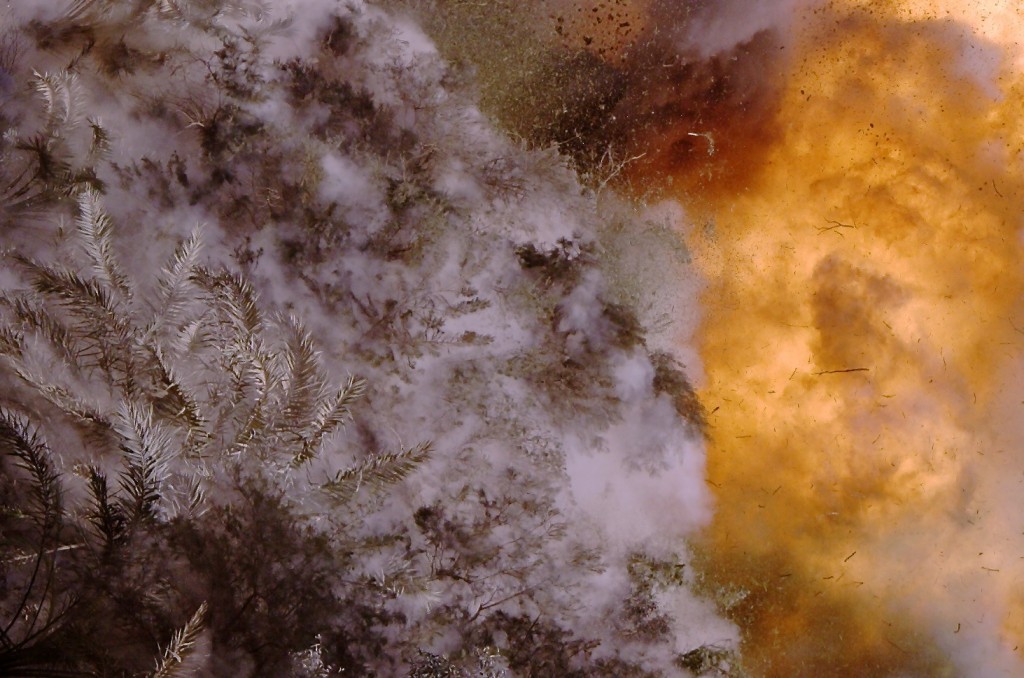
Iraq plunged into yet another crisis last week after a deeply sectarian Iraqi-Syrian terror group captured several cities in the country’s north and center. The events bring to mind a conference I attended last October on the conflict in Syria at King’s College London. When presentations ended and the floor was opened up to audience members with questions, I asked the panel of speakers whether they saw any threads of continuity linking the ongoing Syrian civil war with the preceding war in Iraq.
Jasmine Gani, a fellow at the London School of Economics specializing in the International Relations of the Middle East, replied,
When I was in the region — in Syria — sort of going on and off between 2006 and 2010, I was really startled by the rise in sectarian language from some members of the population. . . . Sectarianism in Iraq is very much the result of the invasion of Iraq and the fomenting of sectarianism there — which spilled over into Syria. And I actually saw and heard that myself over a number of years returning back to Syria.
Two and a half years after the occupation of Iraq by US troops ended, many of the officials relevant to the Iraq War debacle have simply moved on.
The Onion recently ran a (grim) satirical piece titled “George W. Bush Debuts New Paintings of Dogs, Friends, Ghost of Iraqi Child That Follows Him Everywhere,” which cleverly critiqued the former president and the contemptible obsession with his newfound painting hobby. While Bush may not actually be haunted by the legacy of his war of aggression, Gani, in her aforementioned remarks, shows us one way in which millions of people still are. In doing so, she also helps to demonstrate why making sense of the transformations Iraq has undergone since the invasion of 2003 remains an imperative.
Making sense of the past eleven years of Iraqi history is exactly what a number of new books look to do.
Sectarianism in Iraq: Antagonistic Visions of Unity by Fanar Haddad offers a social theory along with an abridged social history to frame the recent rise of the sectarian identity politics referred to by Gani. Fuel on the Fire: Oil and Politics in Occupied Iraq by Greg Muttitt is a vital account of the tussles over the future of Iraq’s post-2003 oil industry that arose between regional and international governments, multinational oil firms, and Iraqi populists, unions, and technocrats. And The Struggle For Iraq’s Future: How Corruption, Incompetence and Sectarianism Have Undermined Democracy by Zaid Al-Ali provides readers with studied insights into Iraq’s deeply flawed US-sponsored 2005 constitutional drafting process and the dysfunctional interplay between the parliamentary and executive branches of Iraqi government.
Iraq’s Sectarian Turn
Fanar Haddad, a research fellow at the National University of Singapore, is widely regarded as a leading authority on sectarian relations in Iraq. He articulates his theories on the nature and formation of sectarian identity most meticulously in Sectarianism in Iraq.
Haddad insists that sectarianism in Iraq cannot simply be understood as a religious phenomenon. By combing through Iraqi political chatter and media, Haddad finds that common sectarian narratives reflect an attachment to the Iraqi nation state, and, among the masses, are comprised of historical or socio-political commentaries. Disputes over theological issues tend to remain “the preserve of specialists and their limited followers,” rather than the driving force behind sectarian relations.
While the notion that Iraqi sectarian narratives are wedded to the nation-state may be fraying at the fringes today, as militants with roots in Iraq pour into Syria, Haddad’s second note, about the often socio-political grievances of those who buy into sectarian narratives, rings true. Many of the polemics, anthems, and poems analyzed in Sectarianism in Iraq are peppered with lines like,
Why no schools [in Iraq]? And the schools/ are in need of repairs six times every two months?/ Because it’s a time of globalization, opening and liberation/ And repairs have been handed to the foreigner.
What Haddad’s book lacks in the way of elegant prose, it makes up for with its nuanced outlook on sectarian identity. His most important argument is summed up in the following sentence:
Sectarian relations are dynamic and are dictated by the constantly advancing and receding salience of sectarian identities in relation to Iraqi national identity.
In other words, identity for Iraqis — much like identity for pretty much anyone else — is elastic. Rather than being primordial, sectarianism in Iraq is something that can be “activated” by the right combination of circumstances.
Herein lies the key to understanding how Iraqis could, at one moment, value the idea of an overarching, inclusive nationalism — as demonstrated by polling data — only to begin to identify more with exclusionary sectarian nationalisms as the occupation dragged on. All three books complement Haddad’s fundamental argument that sectarianism is activated — not predetermined. For instance, in Fuel on the Fire, Muttitt notes that former vice president Adil Abdul Mahdi began
. . . his political career as a Baathist, then joined the Iraqi Communist Party when he fell out with the regime. After a brief flirtation with Maoism he eventually sided with SCIRI [a Shia Islamist grouping].
Perhaps Haddad’s clearest illustration of how identification with one’s sect can be forged is offered through his interview of a woman named Najwa, originally from the rural village of Shomali in Iraq’s Babel province.
In the course of this interview, Najwa reveals that she was unaware of the existence of distinct Islamic sects until she bore witness to the tragic 1991 Iraqi uprising, which followed the end of the first Gulf War. Amidst defiant assertions of sectarian identity by rebels in southern provinces, and concomitant brutal repression by Saddam Hussein’s regime, Najwa came to recognize that she was Shia for the first time.
One key question remains however: Why did sectarian identity, as opposed to another form of identity — say, regional or class-based — become so important in today’s Iraq?
Haddad devotes considerable attention to how national historical developments paved the way for the rise of sectarian narratives, with substantial, but not total, success. He argues that the 1991 uprising mentioned above, the impoverishment of Iraqis caused by the cruel sanctions of the 1990s, and of course the 2003 invasion were decisive in creating Iraq’s contemporary sectarian dynamics.
Haddad is right on all counts and does an admirable job of explaining how the uprising and sanctions altered Iraq’s social relationships. But his relatively short text would have benefited from a more extensive analysis of how events from the late 70s through the 80s affected Iraqis’ imaginations of the sectarian other.
The turn of the decade was a time during which mounting Islamist activism, the Iranian Revolution, unprecedented Iraqi state repression, and, finally, the Iran-Iraq War converged. Events from the period would reverberate over the long run. For example, the origins of SCIRI, the sectarian party that essentially ended up winning Iraq’s first elections, and the 1985 Dujail prison massacre, which Saddam Hussein was officially executed for, can be traced back to the era.
To be fair, Haddad comments on Iraqi social relationships going back to the beginning of the 20th century. Yet in spite of the fact that he acknowledges the seismic shift of the late 70s, he does not devote much space at all to discussing those formative years.
The other two texts discussed here do more to show how occupation authorities stoked sectarian division in Iraq — partially because they focus primarily on the period following 2003.
While Haddad nods to the Coalition Provisional Authorities’ (CPA) decision to establish an ethno-sectarian quota system within the appointed Iraqi Governing Council (IGC), Muttitt and Al-Ali dedicate more space to the issue along with other damaging interventions into Iraq’s new politics. Fuel on the Fire and The Struggle For Iraq’s Future, show that from get-go US officials incorrectly assumed that sectarian political thinking was intrinsic to Iraqi society. Consequently, these military strategists and policymakers would do much to institutionalize divisions.
In one remarkable interview, Muttitt manages to extract a telling quote from Meghan O’Sullivan, a former Bush administration deputy national security advisor. In the interview, she overconfidently claims that the CPA’s “Iraqi math” — a euphemistic reference to the IGC’s ethno-sectarian quota system — “came about not from naiveté, but out of a necessity for bringing the Shia on board.”
Here, I should note that as a CPA official, O’Sullivan worked to make de-Baathification — widely regarded as ruinous to sectarian relations, as many Sunnis felt that the policy contributed to their post-2003 marginalization — especially ferocious.
Iraq’s Oil
Eleven years ago, Greg Muttitt started the investigations that would come together in Fuel on the Fire as an activist against the Iraq War, and it shows. Of the three books discussed in this essay, his is the most unsparing in evaluating American and British occupation authorities’ roles in shaping Iraq’s future.
The book’s narrative revolves around Iraq’s oil, but as the subtitle, Oil and Politics in Occupied Iraq, suggests, the scope of Muttitt’s analysis is broad. Through his inquiries, he manages to unearth many morsels only indirectly related to the development of Iraq’s oil industry. The interview with O’Sullivan, referenced above, is one example.
Another that comes to mind is an admission by Scott Carpenter, a CPA governance team member, indicating that a certain politician was recruited into IGC to “break the back of” an established Iraqi political group with close ties to antiwar Turkey. So much for granting Iraqis the right to choose their own leaders.
So was the Iraq War a war-for-oil? Muttitt never simply says, “Yes it was,” making the point that “because it was a war of aggression . . . there was no single casus belli.” Instead, he gives an overview of the high-level chatter on Iraq’s oil around 2003 in order to depict how the war’s architects viewed the strategic commodity in relation to their national interests.
In December 2001, former counterterrorism director of MI6, Mark Allen, offered the short explanation for how occupying powers viewed the Iraqi oil question when he secretly wrote, “The removal of Saddam Hussein remains a prize because it could give new security to oil supplies.”
By early 2003 sanctions against Iraq, introduced around a decade prior, had become a liability to more than just their woeful Iraqi victims. As the world entered the 21st century, several developing economies started to expand rapidly. Demand for oil began to outpace production, and the costs of finding and developing new oil fields were skyrocketing. In short, the oil glut of the 1990s was ending, and fears that a new oil shock might be on the horizon were palpable.
As Greg Muttitt explains, it was within this context that the topic of Iraq’s oil acquired a renewed salience. The country was estimated to have about 11% of the world’s total oil supply and the production costs were among the cheapest in the world. Yet access to this prize was limited by the sanctions policy.
Major international oil companies had salivated over the prospect of an Iraq free of sanctions and open to investment for some time. For instance, Shell negotiated with Saddam Hussein’s regime between 1994 and 2001 through its creatively named “East Jordan” division. But while oil companies had their own interests, Muttitt argues that American and British policymakers’ foremost concern was in ‘responsibly’ (i.e. at the expense of Saddam) raising Iraq’s oil production rates, rather than in granting contracts to preferred companies.
Of course, he offers some documentation to support this view. Here are just two tidbits in addition to the Mark Allen quote from above:
- In an influential 2001 CSIS report on global energy issues, Robert Ebel — who eventually became a lead advisor on oil and energy in the State Department’s prewar Future of Iraq Project — noted that “Iraq, subjected to multilateral sanctions, may be constrained from building in a timely way the infrastructure necessary to meet the upward curve in energy demand.”
- Moreover, Muttitt shrewdly points out that the 2000 Bush campaign fretted in “A Comprehensive National Energy Policy” over Iraq’s capacity to begin acting as “an important ‘swing producer [of oil],’ with an ability to single-handedly impact and manipulate global markets.” In the same breath, the writers of the campaign statement condemn the Clinton administration for not pushing hard enough to oust the Iraqi regime.
Ironically, the war, which caused Iraqi oil production to collapse, probably ended up exacerbating the looming crisis. The Pentagon’s hopes that the country would reach a production rate of 3.1 million barrels a day between 9 and 21 months of the start of the war proved to be outlandish thanks in large part to “the damage done to the [Iraqi] Oil Ministry’s human and institutional capacity.” The price per barrel would rise from below $30 in 2002 to a peak of over $147 by 2008 — a real oil shock.
However, after much delay, things have started to turn around for those who hoped for more oil exports from the country. In February Iraq’s oil production surged to 3.6 million barrels a day, the highest level in 35 years. As Meghan O’Sullivan and Robert Blackwill euphorically observe in a recently published Foreign Affairs article, oil being brought to market by ‘revolutionary’ technology, like fracking and horizontal drilling, “plus new supplies coming on line from Iraq and elsewhere, could cause a glut in supply.” The former Bush administration foreign policy officials proceed to explain that downward pressures on price resulting from these technologies, and — readers are left to assume — additional Iraqi oil exports, have given the Obama administration more leeway to levy sanctions on Iran in today’s tight oil market.
Rather than conceptions of grand strategy, the bulk of Fuel on the Fire is actually devoted to explaining how and why the Iraqi oil industry changed during the course of the occupation. Muttitt paints a vibrant picture of the processes by which a surprisingly technocratic pre-war oil sector was reshaped into a politicized husk, dependent on foreign expertise and capital. Deteriorating security, escalating civil strife, de-Baathification related purges, and the ideological inclinations of occupation officials and Iraq’s new ruling class were all key here.
Muttitt also narrates the struggles of the veteran Iraqi oil experts, populist politicians, revitalized post-Saddam unions, and civil society groups that toiled to preserve a modicum of independence for their oil industry. This cross-sectarian, populist coalition worked to prevent Iraq’s most prized natural resource from being locked in unfavorable production sharing agreements with international oil companies — to the chagrin of those companies, occupation authorities, and Iraq’s new political elite. While the populist coalition wins the legal battle for Iraq’s oil, the state’s new political elite — typified by former oil minister and current deputy prime minister, Hussein al-Sharistani — ends up signing less than ideal oil contracts with multinationals anyway.
One finishes Muttitt’s book wondering how exactly al-Sharistani could get away with auctioning off Iraq’s assets in violation of Iraqi law and absent of required parliamentary approval. Here is where The Struggle for Iraq’s Future can enlighten us.
Zaid al-Ali is an Iraqi lawyer who worked as a UN legal advisor on Iraq’s constitutional drafting process and on institutional reform efforts. His The Struggle for Iraq’s Future benefits from being the most up to date of the three books, and consequently al-Ali is best equipped to judge Iraq’s progress since the end of occupation.
Although he initially opposed the 2003 war, al-Ali had high hopes that Iraqis would be able to rebuild from decades of genocidal dictatorship and war, and prepare for a better future. These hopes were soon dashed, and an unmistakable air of disappointment runs through every page of the text.
Iraq’s new political elite — a significant portion of whom rose to national prominence as appointed members of the IGC — presides over one of the largest budgets in the Middle East. Yet, paradoxically, this coterie is among the least effective at improving the lives of its citizens. Al-Ali laments the new Iraqi elites’ exploitation of divisive sectarian sentiments; their ostentatious militarism; their inability to tackle broader issues related to Iraq’s corruption, security, and (often overlooked) environmental crises; and their failure to adequately restore basic services like food support and electricity to citizens. As a result, much of the book reads like an extended condemnation of these political figures.
But at its core, The Struggle For Iraq’s Future is less a critique of unsavory individuals than it is a call for the reform of Iraq’s current, dysfunctional system of government. This structure, which was formed in the midst of occupation and civil strife, is seen by al-Ali as a principal engine for the country’s continuing, almost holistic degeneration. And as problems with Iraq’s constitution played a critical role in creating the country’s malfunctioning governmental institutions, revamping the document is al-Ali’s primary proposal for reform. His expertise in comparative constitutional law surfaces in the rewarding parts of the book detailing the 2005 Iraqi constitutional drafting process.
To start, Al-Ali details various problems with the manifestly undemocratic Transitional Administrative Law (TAL). A “CPA appointed small group of US officials and academics, plus two Iraqi-American jurists” in negotiation with the (also CPA appointed) IGC drafted this ‘temporary’ constitution in 2004. The TAL included various provisions well outside the Iraqi mainstream including a US-style gun possession provision “which was unusual not only in the Iraqi constitutional tradition, but also internationally,” and perhaps most importantly, a profoundly unpopular system of radical federalism. The latter set of provisions left the central government with no control over “Iraq’s airspace, roads, railways, education, agriculture, health etc.”
When a transitional national assembly was elected in 2005 and tasked with drafting Iraq’s final constitution, the flawed but more representative body attempted to produce a more popular document. Unfortunately, writing constitutions for states emerging from tyranny takes time (often years) — a luxury the self-serving Bush administration together with an anxious Iraqi Shia clerical establishment did not grant the national assembly. All told, Iraqis were given two months to produce their constitution. The unreasonable deadline forced both democracy and careful attention to detail out of the drafting process and a murky US-backed “leadership council” took over the final phases. Violating past pledges, the council directly inserted provisions from the TAL into the final draft of the constitution. The rushed final draft left even the implementation of fiscal and foreign policy out of Baghdad’s hands.
Al-Ali summarizes the implications of the final constitution clearly: in theory, “the Iraqi state was consecrated as one of the weakest states in the world — even as escalating violence threatened to tear it apart.” In effect, the constitution did more to undermine the state of law in Iraq, leaving state power unchecked. Future governments would simply ignore or work to prevent the implementation of provisions that, in the words of al-Ali, “could never be applied,” and according to commentary by the UN, “[would leave] the central government underpowered and possibly under resourced.”
More irony.
Al-Ali argues that, worse still, important portions of the constitution related to the command of the armed forces, the separation of powers, control over natural resources, and campaign regulation and finance are just sloppy. Ambiguity on these issues has made government accountability a more elusive goal, granted the executive more leeway to formulate and implement policy unilaterally (as demonstrated earlier in the case of Iraq’s oil), and heightened corruption. While this dysfunction helps to make the new Iraqi ruling class more resilient, Iraq’s population loses. Depressingly, Al-Ali — who has since worked on constitutional reform in other states in transition as a result of the Arab Spring — writes that Iraq has become “a warning of what not to do.”
These books show that while Iraq has become more politically free — with a brutal dictator gone, an active civil society, and regular elections — it has also become a hotbed for a virulent, exclusionary form of identity politics. While the government has become adept at exploiting the country’s oil resources, it is bound to costly contracts and wildly ineffective at using oil revenues to social ends. Lastly, while the country is theoretically governed by a non-authoritarian constitution, the document was drafted under duress and has actually sustained, rather than prevented, lawlessness. War, occupation, and the predictable violence that followed propelled these conflicting developments.
The latest crisis in Iraq began as this essay neared completion. Events are still fluid. Large portions of the state in northern and central Iraq have collapsed at an astonishing speed, triggering a mass displacement of people. Incidents including the fall of cities like Mosul and Tikrit to a particularly oppressive al-Qaeda splinter group and dire threats to some of the country’s important oil refining infrastructure help to highlight the precariousness of whatever gains were made after 2003. The twin evils of ceaseless sectarian retrenchment and unaccountable governance have been cast in stark relief.
Far away from the battlegrounds, as rash calls are made for yet more military intervention in Iraq, the unwillingness of some American hawks to grapple with history is also on display. Before lobbying to bomb Iraq for their third decade in a row, these hawks should remember that perhaps half a million lost lives underlie the transformations described above. In contrast, Iraqis are unable to forget such fresh hardships, adding to the perpetual uncertainty over Iraq’s future.
This post may contain affiliate links.







